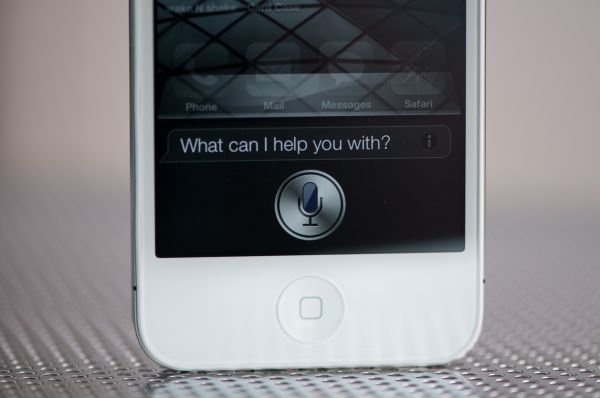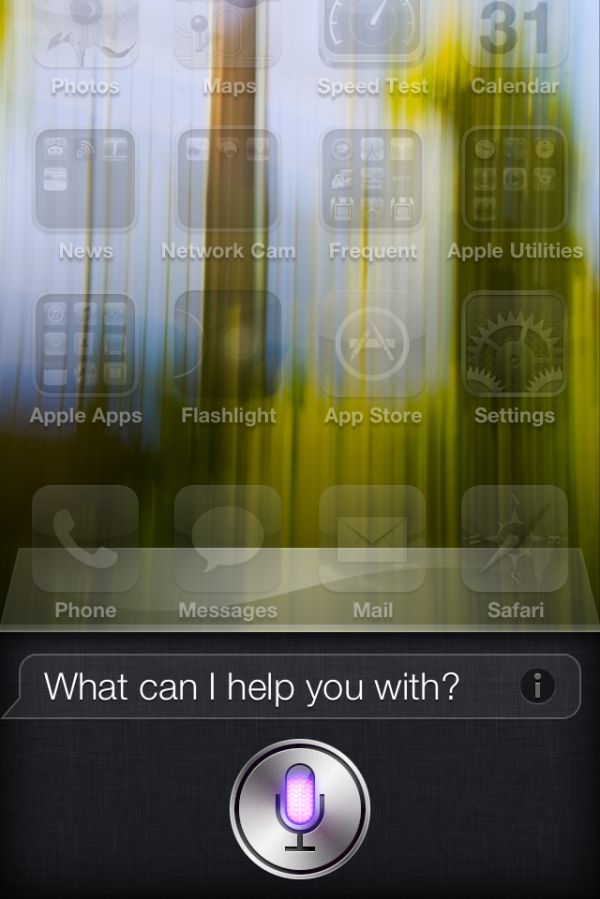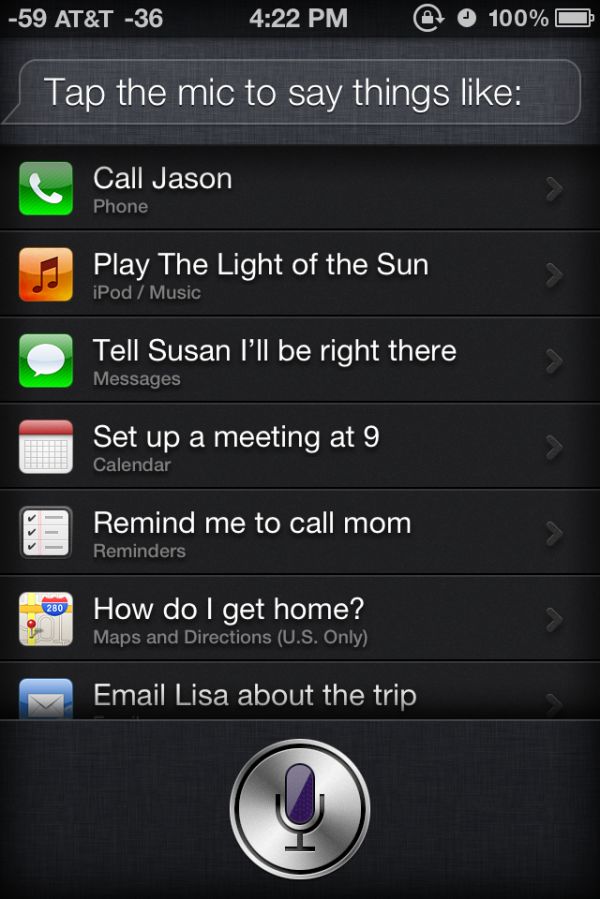Apple iPhone 4S: Thoroughly Reviewed
by Anand Lal Shimpi & Brian Klug on October 31, 2011 7:45 PM EST- Posted in
- Smartphones
- Apple
- Mobile
- iPhone
- iPhone 4S
Siri
Apple can credit much of its success to not only delivering good hardware, but using the hardware to develop new software experiences. With the 4S and iOS 5, most of the software experiences are available on older hardware - the sole exception being Siri.
The expectation that Apple will always deliver more than just a hardware upgrade is likely what made Siri a 4S exclusive (that and controlling the rollout as to not overly burden Apple's servers). The work carried out on the phone itself is minimal compared to what’s done server-side. A quick look at CPU utilization while running a simple Siri query (how many meters are in a mile) reveals the most stressful part of the process is animating the results on the screen. The display process is multithreaded but even then peak usage rarely steps above a single CPU core, in other words - this could have been done on the 4.
Siri is the logical next step from after the existing voice engine on the iPhone 4, which I doubt many people used on a day to day basis. Functionality was limited to a small laundry list of operations, and if you wandered outside the confines of those voice commands, you were left out of luck. I can count the number of times I did anything with the iPhone 4 voice commands on one hand.
Siri originally started as a standalone application, where it initially impressed with the ability to take a conversational approach to voice commands. Apple quickly acquired Siri, built it into iOS 5, and enabled the feature on just the iPhone 4S. At present, the feature only works for English (US, UK, Australia), French, and German, though in 2012 the language engine will also be compatible with Japanese, Chinese, Korean, Italian, and Spanish.
Hold the phone up to your head when not in a call, or long press the home button (which was the previous voice command action) and you’ll get Siri’s purple microphone and a circle button. If you’re familiar with Android’s voice dialogs, this visualization is pretty similar, though the functionality is very different.
Siri also works with bluetooth headsets and normal headsets, including the Apple-supplied button plus microphone earbuds. Normally Siri doesn’t read text messages or emails, but if you have a headset, it then reads everything back to you and becomes a much more powerful hands-free tool. Hold down the action button on a bluetooth earpiece or on the Apple earbud cable, and it will toggle Siri mode the same as holding the home button down. Bluetooth functionality works pretty well, though there’s added latency each time the earpiece audio link is established and torn down that can be unnerving.
Siri leverages Yelp for businesses/restaurants and Wolfram Alpha for any queries that require computation. It is interesting to think of Siri as Apple’s foray into search. Siri isn’t designed to monetize search, but any queries run through Siri definitely don’t line Google’s pockets. Given how much Google depends on search for its revenues and the growth of its businesses, Siri may be viewed as a competitive threat. Perhaps that’s why we don’t see Siri using Google for search?
There are two components to every Siri interaction: your query, and the results it returns. Where Siri is truly impressive is in its ability to understand your queries. You can ask it to tell you the closest Italian restaurants, or just utter the phrase “I want cake” and get a list of options in the area. For the former, Siri just looks for restaurants classified as Italian, for the latter it looks for restaurants whose Yelp reviews mention the word cake. Siri’s ability to dissect and handle the query is impressive, unfortunately its usefulness is gated by how active Yelp users are in your area. Yelp use in Raleigh is disappointing overall, which in turn hurts Siri’s ability to recommend what I’m looking for.


When it works, it works very well. There happen to be a lot of burger options where I live and simply asking Siri “what’s the best burger joint” returned a fairly accurate ranking of my options. The same goes for pizza, but my cake query didn’t really give me useful results either in Raleigh or Durham. Siri is only as smart as the databases that it relies on, and unfortunately simply looking for reviews that mention cake isn’t the best way to direct you to sugary goodness.


The computation aspect of Siri is pretty useful. You can ask Siri simple conversion questions like “how many quarts are in a gallon” or something more complex like “how much is a 15% tip for $247 for five people”. In the case of the latter you’ll get the total tip amount, the per-person share as well as other tip amounts (e.g. 10%, 20%). Take it one step further and ask Siri to tell you when it’s customary to tip and you quickly run into a wall. In this case it’s not the data but Siri’s awareness of the question that’s limiting you.


Given how frequently I’m in meetings, one of the most useful aspects of Siri to me personally is its ability to schedule meetings. I can tell Siri to schedule a meeting with AMD at 2PM Pacific and it’ll offer to create the appointment in my calendar for me. If there’s a conflict, Siri offers resolution options. Combine that with seamless calendar syncing via iCloud and you’ve got a pretty powerful tool. Siri also handles US time zones very well. As you may have gathered from the line above, I can tell Siri to schedule a meeting in a different time zone without having to do the conversion myself. The time zone support breaks down once you go beyond the US unfortunately.

Siri is similarly great for reminders. Using iOS 5’s location based triggers and by simply giving Siri some information ahead of time (e.g. telling it where home and work are in your address book), you can have Siri remind you to buy milk when you leave work or buy a cat when you leave home.
Siri’s voice recognition engine works pretty well out of the box, but also learns individual voice characteristics and dialects on a larger scale. This individually trained language data can optionally be reset as well by just toggling Siri off and back on. I trained Siri for about a week, reset the data, and went through a few commands - it’s obvious that it does tailor a voice profile after a while.
Siri is surprisingly good at following along in conversations, but ultimately it’s still limited to a certain set of tasks, though the list is pretty big. Things like emailing a contact, sending text messages, responding to messages, setting alarms, reminders, and appointments, playing music (based on artist, album, or title), looking basic things up, and then features that are enabled through ties into Yelp and WolframAlpha. Much of what I ask Siri that isn’t an obvious phone function (text, call, email) ends up being directed into a Yelp search, and the depth of interesting redirects here are impressive - everything from telling Siri you’ve soiled yourself (which sends you clothing stores), that you need drugs (which finds addiction treatment centers) to specific things like wanting a certain genre of food nearby. It’s clear that the team responsible for Siri had a lot of fun, and by now the number of interesting easter eggs have been pretty well documented all over the web.



















199 Comments
View All Comments
medi01 - Thursday, November 3, 2011 - link
Find contrast of BEAUTIFUL Galaxy phones on the charts pretty please...doobydoo - Friday, December 2, 2011 - link
Yeah the 'beautiful' screens...The Galaxy screen is what, 480 x 800? on a 4.27 inch screen?
The iPhone 4s is 640 x 960 - on a 3.5 inch screen.
A much higher resolution.
Brian Klug - Sunday, November 6, 2011 - link
"1) Ridiculous BS sentences about "improved vibration" that obviously come straight out of Apple's marketing mouth"I'm sorry you feel that way, but the vibration unit is indeed different, and lends a completely different feel from every other device out there which just uses a spinning counterweight.
I'd encourage you to try it on your own.
-Brian
Samus - Tuesday, November 1, 2011 - link
Great review, thanks Anand! If I weren't so stubborn I'd get an iPhone (because they really are great phones) but I just can't do the Apple thing. I like the openness, tweakability and choices provided by Android phones, but for the general population, the iPhone is pretty much the best option for the high-end market.zanon - Monday, October 31, 2011 - link
Hoorah, the definitive review is here at last! Thanks as always for your hard work on this.And yeah, the 543MP2 is a sick monster of a chip. Imagination Technologies really hit a home run with this one, simply amazing performance. Not just Apple either, I believe the Vita is using the MP4 version of this chip. With the show they've put on this time, I'm very much looking forward to seeing what they do for the Series 6 Rogue ones that I think are still due next year. Or for that matter even if they do an update/shrink of these ones.
Great to see so much competition between graphics in the mobile world, practically every major player has a foot in the water at least. I think this stuff will start to matter more and more too for items beyond games. Applications like further advances in augmented reality seem like they could use plenty of power, and are uniquely suited to mobile platforms. Things will get really nuts when retinal projection displays or some equivalent finally start filtering down into the main market.
Lucian Armasu - Tuesday, November 1, 2011 - link
It's not really about the architecture, though, but about the size of the GPU = more performance. It's 2x the size and has 1.5-2x the performance of Exynos' GPU. Not that surprising.I'm not entirely sure why they had to use such a powerful GPU, though. Is it to make it easier to support higher resolutions? Because it can't be about the games. Why would it get 7x the performance of the previous iPhone 4 GPU, when it can only use 2x of that anyway?
loganin - Tuesday, November 1, 2011 - link
That's a pretty weak and factually wrong claim to discredit Apple's product, not that it's surprising coming from you."Exynos SoC Same Size As Apple A5 In iPad 2"
http://www.itproportal.com/2011/06/07/exynos-soc-s...
zanon - Tuesday, November 1, 2011 - link
loganin already addressed your claptrap regarding size, so we'll just ignore that. A few other bits stand out, however. The first is that, fundamentally, even if you were right so what? You don't win any points for improving in one way vs another, what matters is the result at the end. Regardless of the method PowerVR used the fact that the 543MP2 utterly demolishes the competition, and that it's a beast, would not change.Second, you failed to mention in your "1.5x-2x" the performance bit the fact that it's also clocked *50% slower* then the Exynos. Again, even pretending you were correct, your size difference *still* wouldn't explain the kind of gap we're seeing. Unlike size, which is not perfectly correlated with performance, clock rate pretty directly is. If the 4S's A5 was running at 1.2 GHz, it would be more like 2.8x the performance of the Exynos at the high end.
>>Because it can't be about the games. Why would it get 7x the performance of the previous iPhone 4 GPU, when it can only use 2x of that anyway?
Also, this bit is just WTF. You might have noticed that PC GPUs continue to increase in power? Despite resolutions not continuing to increase? WTF do you mean "you can only use 2x of that"?? At least until the level of complete photorealism with full real time physics modeling of everything is achieved there's always room to spend more power just making the scene look better. Duh.
metafor - Tuesday, November 1, 2011 - link
Erm, GPU clocks are independent of what the CPU is clocked at. I.e. just because the A5's CPU is clocked at 800MHz doesn't mean the GPU is.Apple never really releases what the internal clocks of their various components are running at.
Lucian Armasu - Wednesday, November 2, 2011 - link
Do you even know what 50% slower means? It means half the clock speed. It's not 50% slower. It's 30% slower than Exynos CPU.. It's the Exynos CPU that is "50% faster" than the A5 one.But that's not even what we were talking about. I was talking about the GPU, not the CPU. The GPU has a difference frequency.